Home / The E1 Reaction
Elimination Reactions
The E1 Reaction
Last updated: February 20th, 2025 |
The E1 Reaction – Three Key Pieces of Evidence, and a Mechanism
Last time in this walkthrough on elimination reactions, we talked about two types of elimination reactions. In this post, we’re going to dig a little bit deeper on one type of elimination reaction, and based on what experiments tell us, come up with a hypothesis for how it works.
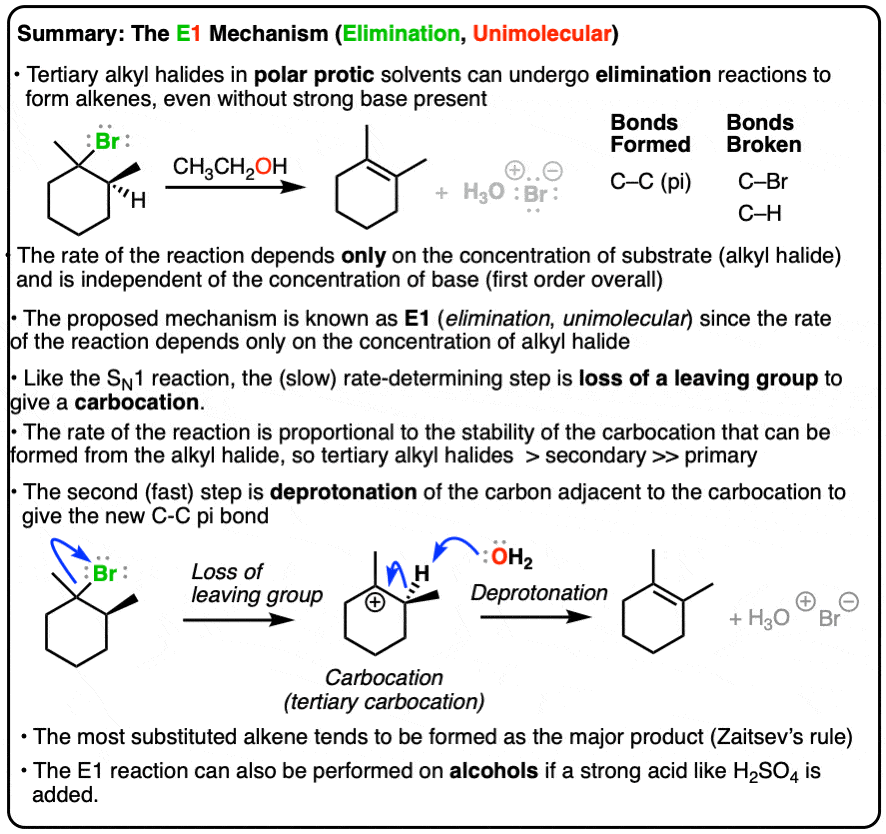
Table of Contents
- How Do We Explain What Happens In This Elimination Reaction (Which We Will Call, “E1”)
- First Clue About The Mechanism of the “E1 Elimination”: The Rate Only Depends On Concentration of Substrate (Not Base)
- The Second Clue About The Mechanism Of The E1 Elimination Reaction – Rate Is Fastest For Tertiary Substrates
- The Third Clue About The Mechanism Of The E1 Elimination Reaction: It Competes with the SN1 Reaction
- Putting It Together: The E1 Mechanism Proceeds Through Loss Of A Leaving Group, Then Deprotonation
- Notes
- Quiz Yourself!
- (Advanced) References and Further Reading
1. How Do We Explain What Happens In This Elimination Reaction (Which We Will Call, “E1”)
Here’s the reaction. First, look at the bonds that are being formed and broken. This is a classic elimination reaction – we’re forming a new C–C(π) bond, and breaking a C–H and C–leaving group (Br here) bond.

But now we want to know more than just “what happens”. We want to understand how it happens. What’s the sequence of bond-forming and bond breaking? To understand HOW it happens, we need to look at what the data tells us.
That’s because chemistry is an empirical science; we look at the evidence, and then work backwards.
2. First Clue About The Mechanism of the “E1 Elimination”: The Rate Only Depends On Concentration of Substrate (Not Base)
Let’s look at the first important clue for this reaction. We can measure reaction rates quite readily. When we vary the concentration of the substrate, the reaction rate increases accordingly. In other words, there is a “first-order” dependence of rate on the concentration of substrate.
However, if we vary the concentration of the base (here, H2O) the rate of the reaction doesn’t change at all.
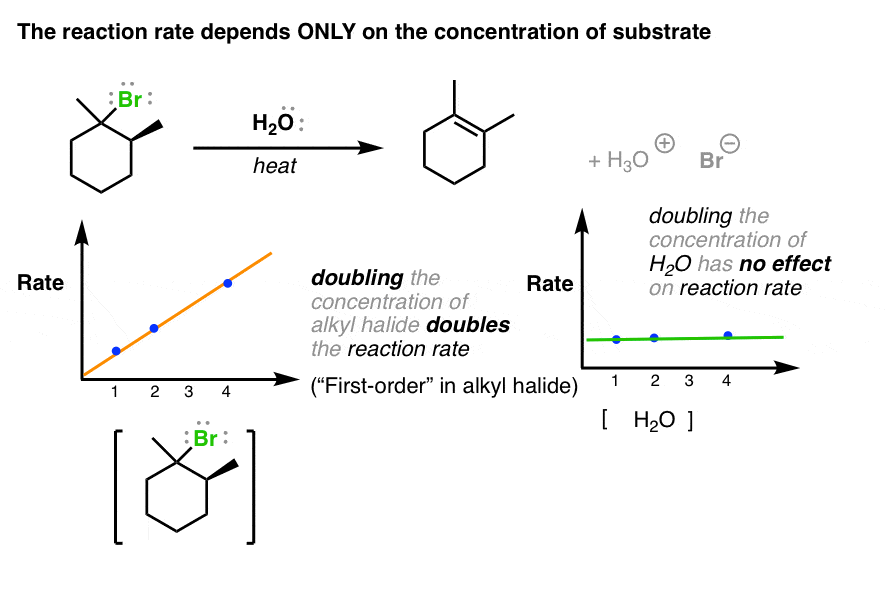
What information can we deduce from this? The rate determining step for this reaction (whatever it is) therefore does not involve the base. Whatever mechanism we draw will have to account for this fact.
The reaction is first-order in the substrate (alkyl halide) and zero order in base (i.e. doubling concentration does not double the rate).
3. The Second Clue About The Mechanism Of The E1 Elimination Reaction – Rate Is Fastest For Tertiary Substrates
Another interesting line of evidence we can obtain from this reaction is through varying the type of substrate, and measure the rate constant that results. So if we take the simple alkyl halide on the far left (below) where the carbon attached to Br is also attached to 3 carbons (this is called a tertiary alkyl halide), the rate is faster than for the middle alkyl halide (a secondary alkyl halide) which is itself faster than a primary alkyl halide (attached to only one carbon in addition to Br). (See post: Primary, Secondary, Tertiary)
So the rate proceeds in the order tertiary (fastest) > secondary >> primary (slowest)

Any mechanism we draw for this reaction would likewise have to account for this fact. What could be going on such that tertiary substrates are faster than primary?
4. The Third Clue About The Mechanism Of The E1 Elimination Reaction: It Competes with the SN1 Reaction
A final interesting clue about the mechanism of this reaction concerns the by-products that are often obtained. For instance, when the alkyl halide below is subjected to these reaction conditions, we do obtain the expected elimination product.
However, we also get substitution reactions in the product mix as well. Remember – substitution reactions involve breakage of C-(leaving group) and formation of C-(nucleophile).
What makes this particular starting alkyl halide particularly interesting is that the carbon attached to Br is a stereocenter. And if we start with a single enantiomer of starting material here, we note that the substitution product formed is a mixture of stereoisomers. Note that both inversion and retention of stereochemistry at the stereocenter has occurred.
We’ve seen this pattern before – it’s an SN1 reaction! (See article: The SN1 Reaction)
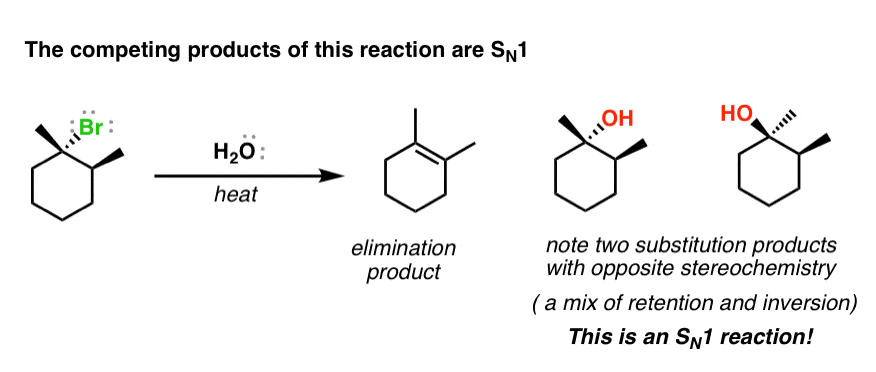
This last part is a very important clue. If an SN1 reaction is occurring in the reaction mixture, looking back at the mechanism of the SN1 could help us think about what type of mechanism might be going on in this case to give us the elimination product.
5. Putting It Together: The E1 Mechanism Proceeds Through Loss Of A Leaving Group, Then Deprotonation
Taking all of these clues into account, what’s the best way to explain what happens? This:
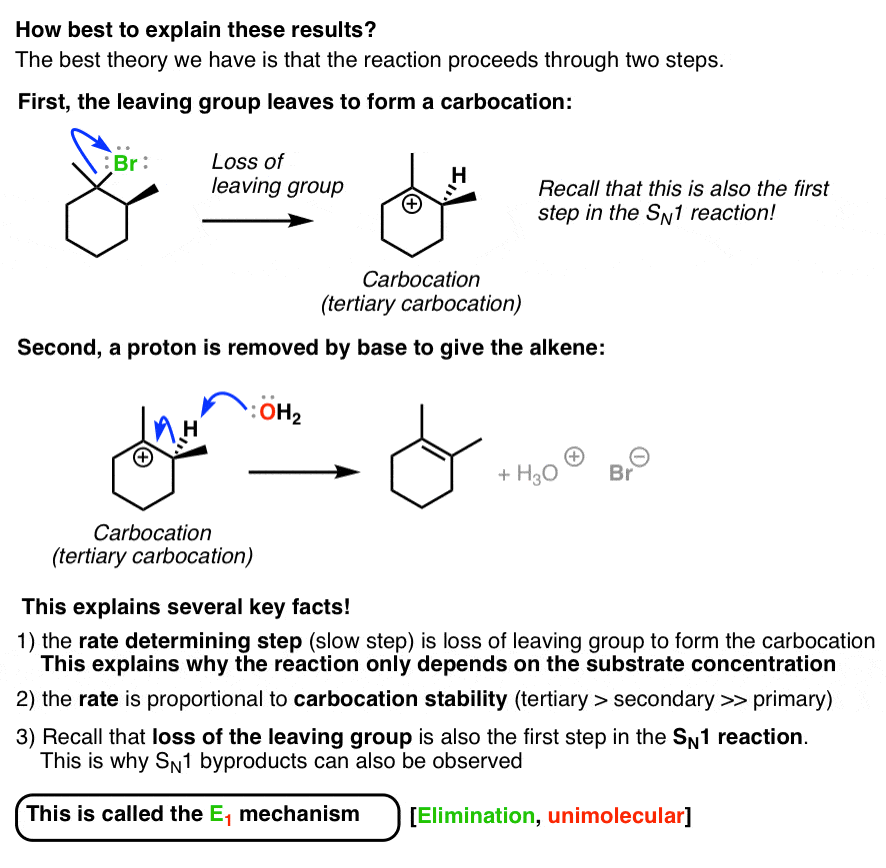
The reaction is proposed to occur in two steps: first, the leaving group leaves, forming a carbocation. Second, base removes a proton, forming the alkene. This nicely fits in with the three clues mentioned above. [Also note that the more substituted alkene is formed here, following Zaitsev’s rule].
Similar to the SN1 mechanism, this is referred to as the E1 mechanism (elimination, unimolecular).
So what’s going on in the other type of elimination reaction? That’s the topic for the next post!
Notes
Related Articles
- The E2 Mechanism
- Elimination Reactions (2): The Zaitsev Rule
- Alkene Stability
- Primary, Secondary, Tertiary, Quaternary In Organic Chemistry
- E1 vs E2: Comparing the E1 and E2 Reactions
- 3 Factors That Stabilize Carbocations
- Elimination (E1) Practice Problems And Solutions (MOC Membership)
- Elimination (E2) Practice Problems and Solutions (MOC Membership)
- Identifying Where Substitution and Elimination Reactions Happen
Quiz Yourself!
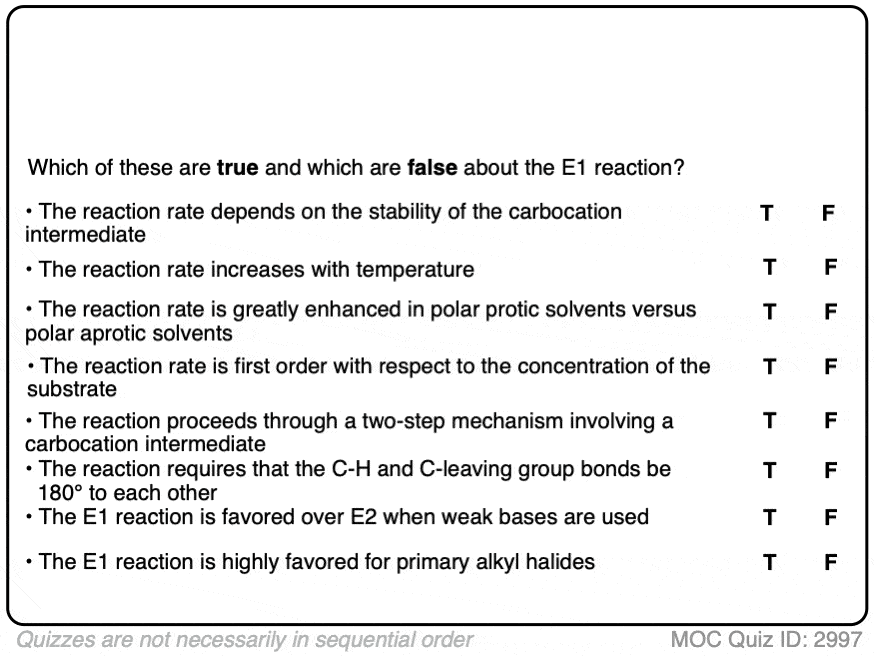 Click to Flip
Click to Flip
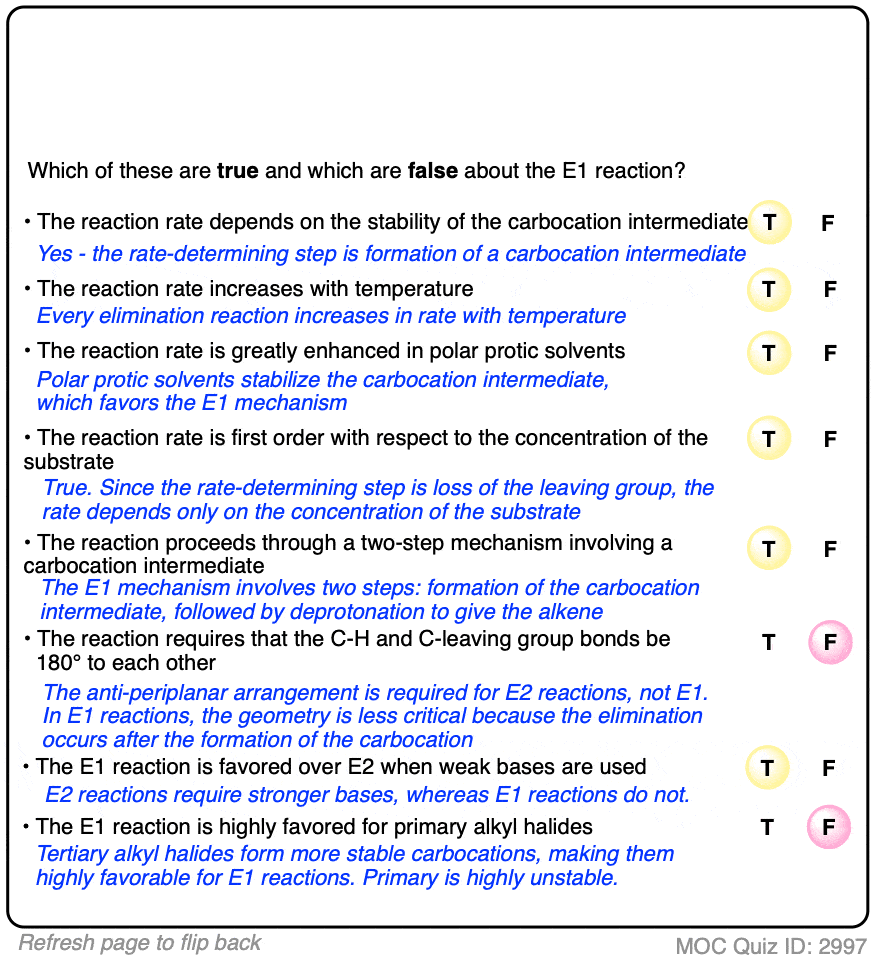
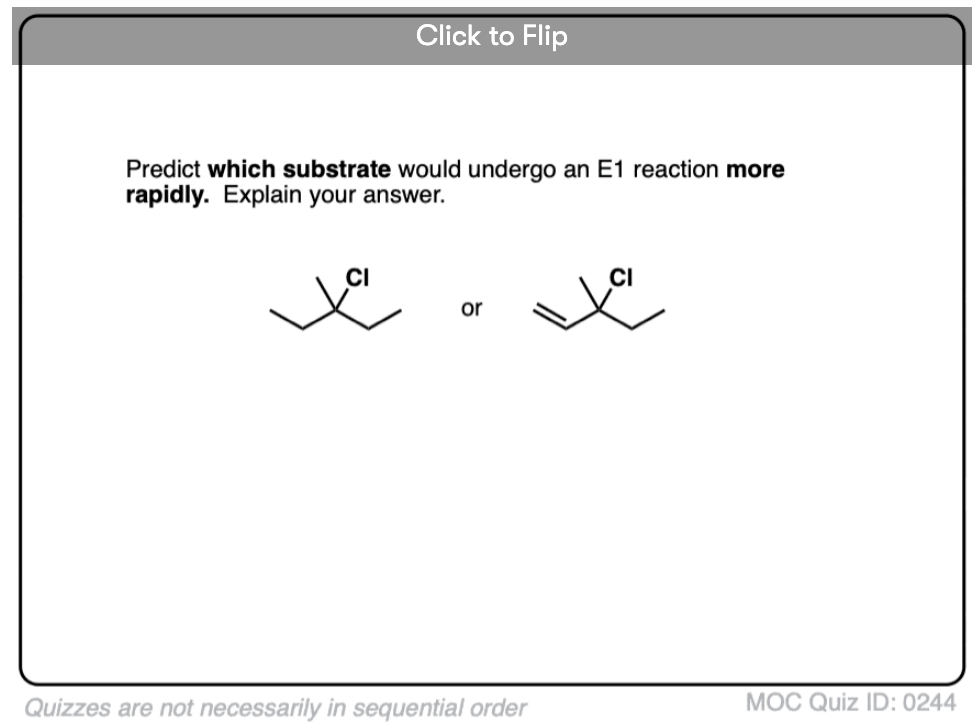
Become a MOC member to see the clickable quiz with answers on the back.
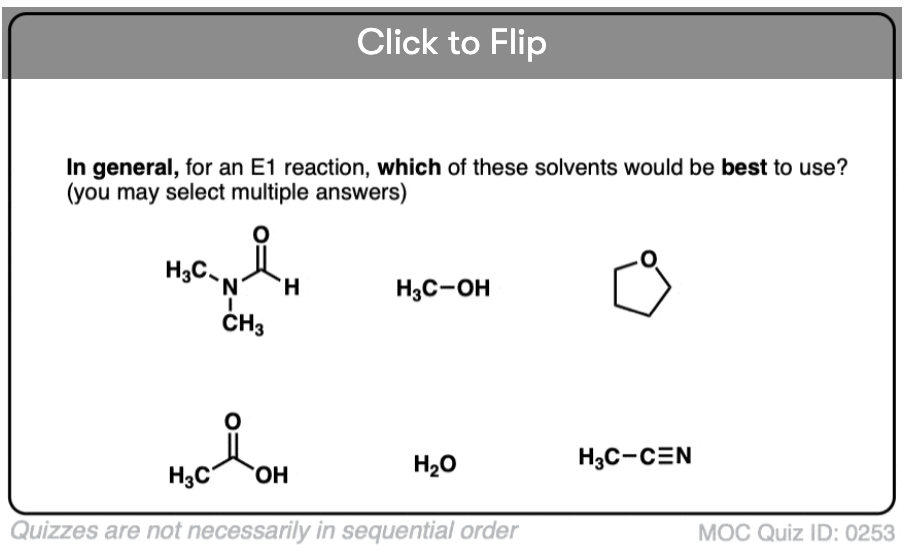
Become a MOC member to see the clickable quiz with answers on the back.
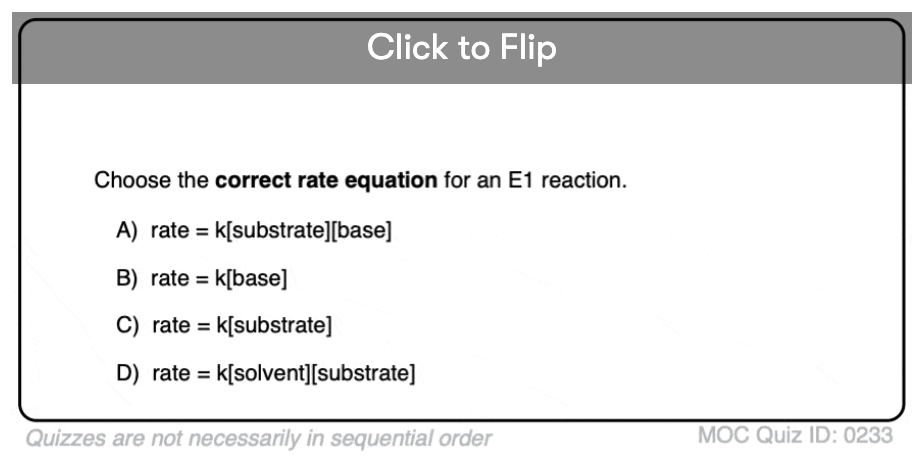
Become a MOC member to see the clickable quiz with answers on the back.
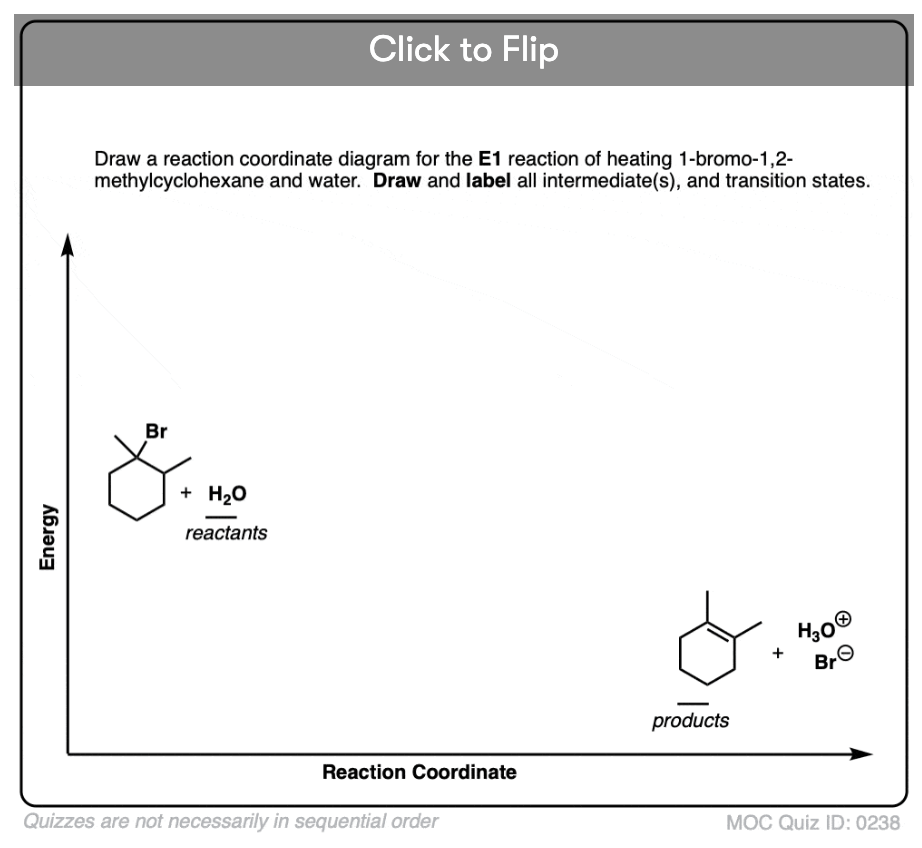
Become a MOC member to see the clickable quiz with answers on the back.
(Advanced) References and Further Reading
- Mechanisms of Elimination Reactions, by Saunders and Cockerill, 1973, p. 210.
This book states, “There are three main factors that favor the E1 mechanism: a substrate that gives a relatively stable carbocation, an ionizing solvent, and the absence of strong bases or nucleophiles“. - Hydrolysis of Secondary and Tertiary Alkyl Halides
Edward D. Hughes
Journal of the American Chemical Society 1935, 57 (4), 708-709
DOI: 10.1021/ja01307a033
An early paper, and likely the first paper to feature the term “E1”. This paper also notes that the E1 reaction competes with the SN1 reaction for several substrates. - Unimolecular Elimination and the Significance of the Electrical Conduction, Racemization and Halogen Replacement of Organic Halides in Solution.
HUGHES, E., INGOLD, C. & SCOTT, A.
Nature 1936, 138, 120–121
DOI: 1038/138120b0
This paper describes electrical conductivity experiments of tertiary and secondary substrates in SO2 with HCl in support of the E1 mechanism. - Ion Pairs in Elimination
Cocivera and S. Winstein
Journal of the American Chemical Society 1963, 85 (11), 1702-1703
DOI: 10.1021/ja00894a046
In highly polar and dissociating solvents (like aqueous alcohols) the carbocation is relatively “free” and the amount of alkene product is independent of the nature of the leaving group. In this paper, Prof. Winstein shows that in less polar solvents, the carbocation is less “free” and tight ion pairs are formed. Consequently the elimination/substitution ratio can be strongly dependent on the basicity of the leaving group. The key finding here is that more basic leaving groups (Cl-, Br-) lead to more E1 products than less basic leaving groups (I-, S(CH3)2 ). Furthermore, the proportion of E1 products in less polar solvents are higher than those in more dissociating solvents. - Mechanism of elimination reactions. Part X. Kinetics of olefin elimination from isopropyl, sec.-butyl, 2-n-amyl, and 3-n-amyl bromides in acidic and alkaline alcoholic media
M. L. Dhar, E. D. Hughes, and C. K. Ingold
J. Chem. Soc. 1948, 2058-2065
DOI: 10.1039/JR9480002058
Table III in this paper shows that secondary substrates are generally poor substrates for E1 reactions – yields ranged from 4.7% to 17.4%. - Mechanism of elimination reactions. Part VIII. Temperature effects on rates and product-proportions in uni- and bi-molecular substitution and elimination reactions of alkyl halides and sulphonium salts in hydroxylic solvents
K. A. Cooper, E. D. Hughes, C. K. Ingold, and B. J. MacNulty
J. Chem. Soc. 1948, 2049-2054
DOI: 10.1039/JR9480002049
On how temperature effects elimination/substitution ratio, Ingold states here: “[..] for any given pair of simultaneous bimolecular processes, the elimination has, in each of the investigated cases, an Arrhenius energy of activation which lies higher than that of the accompanying substitution by 1-2 kcal/g.-mol. The elimination thus has always the larger temperature coefficient, so that a rise of temperature increases the proportions in which olefin is formed.”
00 General Chemistry Review
01 Bonding, Structure, and Resonance
- How Do We Know Methane (CH4) Is Tetrahedral?
- Hybrid Orbitals and Hybridization
- How To Determine Hybridization: A Shortcut
- Orbital Hybridization And Bond Strengths
- Sigma bonds come in six varieties: Pi bonds come in one
- A Key Skill: How to Calculate Formal Charge
- The Four Intermolecular Forces and How They Affect Boiling Points
- 3 Trends That Affect Boiling Points
- How To Use Electronegativity To Determine Electron Density (and why NOT to trust formal charge)
- Introduction to Resonance
- How To Use Curved Arrows To Interchange Resonance Forms
- Evaluating Resonance Forms (1) - The Rule of Least Charges
- How To Find The Best Resonance Structure By Applying Electronegativity
- Evaluating Resonance Structures With Negative Charges
- Evaluating Resonance Structures With Positive Charge
- Exploring Resonance: Pi-Donation
- Exploring Resonance: Pi-acceptors
- In Summary: Evaluating Resonance Structures
- Drawing Resonance Structures: 3 Common Mistakes To Avoid
- How to apply electronegativity and resonance to understand reactivity
- Bond Hybridization Practice
- Structure and Bonding Practice Quizzes
- Resonance Structures Practice
02 Acid Base Reactions
- Introduction to Acid-Base Reactions
- Acid Base Reactions In Organic Chemistry
- The Stronger The Acid, The Weaker The Conjugate Base
- Walkthrough of Acid-Base Reactions (3) - Acidity Trends
- Five Key Factors That Influence Acidity
- Acid-Base Reactions: Introducing Ka and pKa
- How to Use a pKa Table
- The pKa Table Is Your Friend
- A Handy Rule of Thumb for Acid-Base Reactions
- Acid Base Reactions Are Fast
- pKa Values Span 60 Orders Of Magnitude
- How Protonation and Deprotonation Affect Reactivity
- Acid Base Practice Problems
03 Alkanes and Nomenclature
- Meet the (Most Important) Functional Groups
- Condensed Formulas: Deciphering What the Brackets Mean
- Hidden Hydrogens, Hidden Lone Pairs, Hidden Counterions
- Don't Be Futyl, Learn The Butyls
- Primary, Secondary, Tertiary, Quaternary In Organic Chemistry
- Branching, and Its Affect On Melting and Boiling Points
- The Many, Many Ways of Drawing Butane
- Wedge And Dash Convention For Tetrahedral Carbon
- Common Mistakes in Organic Chemistry: Pentavalent Carbon
- Table of Functional Group Priorities for Nomenclature
- Summary Sheet - Alkane Nomenclature
- Organic Chemistry IUPAC Nomenclature Demystified With A Simple Puzzle Piece Approach
- Boiling Point Quizzes
- Organic Chemistry Nomenclature Quizzes
04 Conformations and Cycloalkanes
- Staggered vs Eclipsed Conformations of Ethane
- Conformational Isomers of Propane
- Newman Projection of Butane (and Gauche Conformation)
- Introduction to Cycloalkanes
- Geometric Isomers In Small Rings: Cis And Trans Cycloalkanes
- Calculation of Ring Strain In Cycloalkanes
- Cycloalkanes - Ring Strain In Cyclopropane And Cyclobutane
- Cyclohexane Conformations
- Cyclohexane Chair Conformation: An Aerial Tour
- How To Draw The Cyclohexane Chair Conformation
- The Cyclohexane Chair Flip
- The Cyclohexane Chair Flip - Energy Diagram
- Substituted Cyclohexanes - Axial vs Equatorial
- Ranking The Bulkiness Of Substituents On Cyclohexanes: "A-Values"
- Cyclohexane Chair Conformation Stability: Which One Is Lower Energy?
- Fused Rings - Cis-Decalin and Trans-Decalin
- Naming Bicyclic Compounds - Fused, Bridged, and Spiro
- Bredt's Rule (And Summary of Cycloalkanes)
- Newman Projection Practice
- Cycloalkanes Practice Problems
05 A Primer On Organic Reactions
- The Most Important Question To Ask When Learning a New Reaction
- Curved Arrows (for reactions)
- Nucleophiles and Electrophiles
- The Three Classes of Nucleophiles
- Nucleophilicity vs. Basicity
- What Makes A Good Nucleophile?
- What Makes A Good Leaving Group?
- 3 Factors That Stabilize Carbocations
- Equilibrium and Energy Relationships
- 7 Factors that stabilize negative charge in organic chemistry
- 7 Factors That Stabilize Positive Charge in Organic Chemistry
- What's a Transition State?
- Hammond's Postulate
- Learning Organic Chemistry Reactions: A Checklist (PDF)
- Introduction to Oxidative Cleavage Reactions
06 Free Radical Reactions
- Bond Dissociation Energies = Homolytic Cleavage
- Free Radical Reactions
- 3 Factors That Stabilize Free Radicals
- What Factors Destabilize Free Radicals?
- Bond Strengths And Radical Stability
- Free Radical Initiation: Why Is "Light" Or "Heat" Required?
- Initiation, Propagation, Termination
- Monochlorination Products Of Propane, Pentane, And Other Alkanes
- Selectivity In Free Radical Reactions
- Selectivity in Free Radical Reactions: Bromination vs. Chlorination
- Halogenation At Tiffany's
- Allylic Bromination
- Bonus Topic: Allylic Rearrangements
- In Summary: Free Radicals
- Synthesis (2) - Reactions of Alkanes
- Free Radicals Practice Quizzes
07 Stereochemistry and Chirality
- Types of Isomers: Constitutional Isomers, Stereoisomers, Enantiomers, and Diastereomers
- How To Draw The Enantiomer Of A Chiral Molecule
- How To Draw A Bond Rotation
- Introduction to Assigning (R) and (S): The Cahn-Ingold-Prelog Rules
- Assigning Cahn-Ingold-Prelog (CIP) Priorities (2) - The Method of Dots
- Enantiomers vs Diastereomers vs The Same? Two Methods For Solving Problems
- Assigning R/S To Newman Projections (And Converting Newman To Line Diagrams)
- How To Determine R and S Configurations On A Fischer Projection
- The Meso Trap
- Optical Rotation, Optical Activity, and Specific Rotation
- Optical Purity and Enantiomeric Excess
- What's a Racemic Mixture?
- Chiral Allenes And Chiral Axes
- Stereochemistry Practice Problems and Quizzes
08 Substitution Reactions
- Nucleophilic Substitution Reactions - Introduction
- Two Types of Nucleophilic Substitution Reactions
- The SN2 Mechanism
- Why the SN2 Reaction Is Powerful
- The SN1 Mechanism
- The Conjugate Acid Is A Better Leaving Group
- Comparing the SN1 and SN2 Reactions
- Polar Protic? Polar Aprotic? Nonpolar? All About Solvents
- Steric Hindrance is Like a Fat Goalie
- Common Blind Spot: Intramolecular Reactions
- Substitution Practice - SN1
- Substitution Practice - SN2
09 Elimination Reactions
- Elimination Reactions (1): Introduction And The Key Pattern
- Elimination Reactions (2): The Zaitsev Rule
- Elimination Reactions Are Favored By Heat
- Two Elimination Reaction Patterns
- The E1 Reaction
- The E2 Mechanism
- E1 vs E2: Comparing the E1 and E2 Reactions
- Antiperiplanar Relationships: The E2 Reaction and Cyclohexane Rings
- Bulky Bases in Elimination Reactions
- Comparing the E1 vs SN1 Reactions
- Elimination (E1) Reactions With Rearrangements
- E1cB - Elimination (Unimolecular) Conjugate Base
- Elimination (E1) Practice Problems And Solutions
- Elimination (E2) Practice Problems and Solutions
10 Rearrangements
11 SN1/SN2/E1/E2 Decision
- Identifying Where Substitution and Elimination Reactions Happen
- Deciding SN1/SN2/E1/E2 (1) - The Substrate
- Deciding SN1/SN2/E1/E2 (2) - The Nucleophile/Base
- SN1 vs E1 and SN2 vs E2 : The Temperature
- Deciding SN1/SN2/E1/E2 - The Solvent
- Wrapup: The Key Factors For Determining SN1/SN2/E1/E2
- Alkyl Halide Reaction Map And Summary
- SN1 SN2 E1 E2 Practice Problems
12 Alkene Reactions
- E and Z Notation For Alkenes (+ Cis/Trans)
- Alkene Stability
- Alkene Addition Reactions: "Regioselectivity" and "Stereoselectivity" (Syn/Anti)
- Stereoselective and Stereospecific Reactions
- Hydrohalogenation of Alkenes and Markovnikov's Rule
- Hydration of Alkenes With Aqueous Acid
- Rearrangements in Alkene Addition Reactions
- Halogenation of Alkenes and Halohydrin Formation
- Oxymercuration Demercuration of Alkenes
- Hydroboration Oxidation of Alkenes
- m-CPBA (meta-chloroperoxybenzoic acid)
- OsO4 (Osmium Tetroxide) for Dihydroxylation of Alkenes
- Palladium on Carbon (Pd/C) for Catalytic Hydrogenation of Alkenes
- Cyclopropanation of Alkenes
- A Fourth Alkene Addition Pattern - Free Radical Addition
- Alkene Reactions: Ozonolysis
- Summary: Three Key Families Of Alkene Reaction Mechanisms
- Synthesis (4) - Alkene Reaction Map, Including Alkyl Halide Reactions
- Alkene Reactions Practice Problems
13 Alkyne Reactions
- Acetylides from Alkynes, And Substitution Reactions of Acetylides
- Partial Reduction of Alkynes With Lindlar's Catalyst
- Partial Reduction of Alkynes With Na/NH3 To Obtain Trans Alkenes
- Alkyne Hydroboration With "R2BH"
- Hydration and Oxymercuration of Alkynes
- Hydrohalogenation of Alkynes
- Alkyne Halogenation: Bromination, Chlorination, and Iodination of Alkynes
- Alkyne Reactions - The "Concerted" Pathway
- Alkenes To Alkynes Via Halogenation And Elimination Reactions
- Alkynes Are A Blank Canvas
- Synthesis (5) - Reactions of Alkynes
- Alkyne Reactions Practice Problems With Answers
14 Alcohols, Epoxides and Ethers
- Alcohols - Nomenclature and Properties
- Alcohols Can Act As Acids Or Bases (And Why It Matters)
- Alcohols - Acidity and Basicity
- The Williamson Ether Synthesis
- Ethers From Alkenes, Tertiary Alkyl Halides and Alkoxymercuration
- Alcohols To Ethers via Acid Catalysis
- Cleavage Of Ethers With Acid
- Epoxides - The Outlier Of The Ether Family
- Opening of Epoxides With Acid
- Epoxide Ring Opening With Base
- Making Alkyl Halides From Alcohols
- Tosylates And Mesylates
- PBr3 and SOCl2
- Elimination Reactions of Alcohols
- Elimination of Alcohols To Alkenes With POCl3
- Alcohol Oxidation: "Strong" and "Weak" Oxidants
- Demystifying The Mechanisms of Alcohol Oxidations
- Protecting Groups For Alcohols
- Thiols And Thioethers
- Calculating the oxidation state of a carbon
- Oxidation and Reduction in Organic Chemistry
- Oxidation Ladders
- SOCl2 Mechanism For Alcohols To Alkyl Halides: SN2 versus SNi
- Alcohol Reactions Roadmap (PDF)
- Alcohol Reaction Practice Problems
- Epoxide Reaction Quizzes
- Oxidation and Reduction Practice Quizzes
15 Organometallics
- What's An Organometallic?
- Formation of Grignard and Organolithium Reagents
- Organometallics Are Strong Bases
- Reactions of Grignard Reagents
- Protecting Groups In Grignard Reactions
- Synthesis Problems Involving Grignard Reagents
- Grignard Reactions And Synthesis (2)
- Organocuprates (Gilman Reagents): How They're Made
- Gilman Reagents (Organocuprates): What They're Used For
- The Heck, Suzuki, and Olefin Metathesis Reactions (And Why They Don't Belong In Most Introductory Organic Chemistry Courses)
- Reaction Map: Reactions of Organometallics
- Grignard Practice Problems
16 Spectroscopy
- Degrees of Unsaturation (or IHD, Index of Hydrogen Deficiency)
- Conjugation And Color (+ How Bleach Works)
- Introduction To UV-Vis Spectroscopy
- UV-Vis Spectroscopy: Absorbance of Carbonyls
- UV-Vis Spectroscopy: Practice Questions
- Bond Vibrations, Infrared Spectroscopy, and the "Ball and Spring" Model
- Infrared Spectroscopy: A Quick Primer On Interpreting Spectra
- IR Spectroscopy: 4 Practice Problems
- 1H NMR: How Many Signals?
- Homotopic, Enantiotopic, Diastereotopic
- Diastereotopic Protons in 1H NMR Spectroscopy: Examples
- 13-C NMR - How Many Signals
- Liquid Gold: Pheromones In Doe Urine
- Natural Product Isolation (1) - Extraction
- Natural Product Isolation (2) - Purification Techniques, An Overview
- Structure Determination Case Study: Deer Tarsal Gland Pheromone
17 Dienes and MO Theory
- What To Expect In Organic Chemistry 2
- Are these molecules conjugated?
- Conjugation And Resonance In Organic Chemistry
- Bonding And Antibonding Pi Orbitals
- Molecular Orbitals of The Allyl Cation, Allyl Radical, and Allyl Anion
- Pi Molecular Orbitals of Butadiene
- Reactions of Dienes: 1,2 and 1,4 Addition
- Thermodynamic and Kinetic Products
- More On 1,2 and 1,4 Additions To Dienes
- s-cis and s-trans
- The Diels-Alder Reaction
- Cyclic Dienes and Dienophiles in the Diels-Alder Reaction
- Stereochemistry of the Diels-Alder Reaction
- Exo vs Endo Products In The Diels Alder: How To Tell Them Apart
- HOMO and LUMO In the Diels Alder Reaction
- Why Are Endo vs Exo Products Favored in the Diels-Alder Reaction?
- Diels-Alder Reaction: Kinetic and Thermodynamic Control
- The Retro Diels-Alder Reaction
- The Intramolecular Diels Alder Reaction
- Regiochemistry In The Diels-Alder Reaction
- The Cope and Claisen Rearrangements
- Electrocyclic Reactions
- Electrocyclic Ring Opening And Closure (2) - Six (or Eight) Pi Electrons
- Diels Alder Practice Problems
- Molecular Orbital Theory Practice
18 Aromaticity
- Introduction To Aromaticity
- Rules For Aromaticity
- Huckel's Rule: What Does 4n+2 Mean?
- Aromatic, Non-Aromatic, or Antiaromatic? Some Practice Problems
- Antiaromatic Compounds and Antiaromaticity
- The Pi Molecular Orbitals of Benzene
- The Pi Molecular Orbitals of Cyclobutadiene
- Frost Circles
- Aromaticity Practice Quizzes
19 Reactions of Aromatic Molecules
- Electrophilic Aromatic Substitution: Introduction
- Activating and Deactivating Groups In Electrophilic Aromatic Substitution
- Electrophilic Aromatic Substitution - The Mechanism
- Ortho-, Para- and Meta- Directors in Electrophilic Aromatic Substitution
- Understanding Ortho, Para, and Meta Directors
- Why are halogens ortho- para- directors?
- Disubstituted Benzenes: The Strongest Electron-Donor "Wins"
- Electrophilic Aromatic Substitutions (1) - Halogenation of Benzene
- Electrophilic Aromatic Substitutions (2) - Nitration and Sulfonation
- EAS Reactions (3) - Friedel-Crafts Acylation and Friedel-Crafts Alkylation
- Intramolecular Friedel-Crafts Reactions
- Nucleophilic Aromatic Substitution (NAS)
- Nucleophilic Aromatic Substitution (2) - The Benzyne Mechanism
- Reactions on the "Benzylic" Carbon: Bromination And Oxidation
- The Wolff-Kishner, Clemmensen, And Other Carbonyl Reductions
- More Reactions on the Aromatic Sidechain: Reduction of Nitro Groups and the Baeyer Villiger
- Aromatic Synthesis (1) - "Order Of Operations"
- Synthesis of Benzene Derivatives (2) - Polarity Reversal
- Aromatic Synthesis (3) - Sulfonyl Blocking Groups
- Birch Reduction
- Synthesis (7): Reaction Map of Benzene and Related Aromatic Compounds
- Aromatic Reactions and Synthesis Practice
- Electrophilic Aromatic Substitution Practice Problems
20 Aldehydes and Ketones
- What's The Alpha Carbon In Carbonyl Compounds?
- Nucleophilic Addition To Carbonyls
- Aldehydes and Ketones: 14 Reactions With The Same Mechanism
- Sodium Borohydride (NaBH4) Reduction of Aldehydes and Ketones
- Grignard Reagents For Addition To Aldehydes and Ketones
- Wittig Reaction
- Hydrates, Hemiacetals, and Acetals
- Imines - Properties, Formation, Reactions, and Mechanisms
- All About Enamines
- Breaking Down Carbonyl Reaction Mechanisms: Reactions of Anionic Nucleophiles (Part 2)
- Aldehydes Ketones Reaction Practice
21 Carboxylic Acid Derivatives
- Nucleophilic Acyl Substitution (With Negatively Charged Nucleophiles)
- Addition-Elimination Mechanisms With Neutral Nucleophiles (Including Acid Catalysis)
- Basic Hydrolysis of Esters - Saponification
- Transesterification
- Proton Transfer
- Fischer Esterification - Carboxylic Acid to Ester Under Acidic Conditions
- Lithium Aluminum Hydride (LiAlH4) For Reduction of Carboxylic Acid Derivatives
- LiAlH[Ot-Bu]3 For The Reduction of Acid Halides To Aldehydes
- Di-isobutyl Aluminum Hydride (DIBAL) For The Partial Reduction of Esters and Nitriles
- Amide Hydrolysis
- Thionyl Chloride (SOCl2) And Conversion of Carboxylic Acids to Acid Halides
- Diazomethane (CH2N2)
- Carbonyl Chemistry: Learn Six Mechanisms For the Price Of One
- Making Music With Mechanisms (PADPED)
- Carboxylic Acid Derivatives Practice Questions
22 Enols and Enolates
- Keto-Enol Tautomerism
- Enolates - Formation, Stability, and Simple Reactions
- Kinetic Versus Thermodynamic Enolates
- Aldol Addition and Condensation Reactions
- Reactions of Enols - Acid-Catalyzed Aldol, Halogenation, and Mannich Reactions
- Claisen Condensation and Dieckmann Condensation
- Decarboxylation
- The Malonic Ester and Acetoacetic Ester Synthesis
- The Michael Addition Reaction and Conjugate Addition
- The Robinson Annulation
- Haloform Reaction
- The Hell–Volhard–Zelinsky Reaction
- Enols and Enolates Practice Quizzes
23 Amines
- The Amide Functional Group: Properties, Synthesis, and Nomenclature
- Basicity of Amines And pKaH
- 5 Key Basicity Trends of Amines
- The Mesomeric Effect And Aromatic Amines
- Nucleophilicity of Amines
- Alkylation of Amines (Sucks!)
- Reductive Amination
- The Gabriel Synthesis
- Some Reactions of Azides
- The Hofmann Elimination
- The Hofmann and Curtius Rearrangements
- The Cope Elimination
- Protecting Groups for Amines - Carbamates
- The Strecker Synthesis of Amino Acids
- Introduction to Peptide Synthesis
- Reactions of Diazonium Salts: Sandmeyer and Related Reactions
- Amine Practice Questions
24 Carbohydrates
- D and L Notation For Sugars
- Pyranoses and Furanoses: Ring-Chain Tautomerism In Sugars
- What is Mutarotation?
- Reducing Sugars
- The Big Damn Post Of Carbohydrate-Related Chemistry Definitions
- The Haworth Projection
- Converting a Fischer Projection To A Haworth (And Vice Versa)
- Reactions of Sugars: Glycosylation and Protection
- The Ruff Degradation and Kiliani-Fischer Synthesis
- Isoelectric Points of Amino Acids (and How To Calculate Them)
- Carbohydrates Practice
- Amino Acid Quizzes
25 Fun and Miscellaneous
- A Gallery of Some Interesting Molecules From Nature
- Screw Organic Chemistry, I'm Just Going To Write About Cats
- On Cats, Part 1: Conformations and Configurations
- On Cats, Part 2: Cat Line Diagrams
- On Cats, Part 4: Enantiocats
- On Cats, Part 6: Stereocenters
- Organic Chemistry Is Shit
- The Organic Chemistry Behind "The Pill"
- Maybe they should call them, "Formal Wins" ?
- Why Do Organic Chemists Use Kilocalories?
- The Principle of Least Effort
- Organic Chemistry GIFS - Resonance Forms
- Reproducibility In Organic Chemistry
- What Holds The Nucleus Together?
- How Reactions Are Like Music
- Organic Chemistry and the New MCAT
26 Organic Chemistry Tips and Tricks
- Common Mistakes: Formal Charges Can Mislead
- Partial Charges Give Clues About Electron Flow
- Draw The Ugly Version First
- Organic Chemistry Study Tips: Learn the Trends
- The 8 Types of Arrows In Organic Chemistry, Explained
- Top 10 Skills To Master Before An Organic Chemistry 2 Final
- Common Mistakes with Carbonyls: Carboxylic Acids... Are Acids!
- Planning Organic Synthesis With "Reaction Maps"
- Alkene Addition Pattern #1: The "Carbocation Pathway"
- Alkene Addition Pattern #2: The "Three-Membered Ring" Pathway
- Alkene Addition Pattern #3: The "Concerted" Pathway
- Number Your Carbons!
- The 4 Major Classes of Reactions in Org 1
- How (and why) electrons flow
- Grossman's Rule
- Three Exam Tips
- A 3-Step Method For Thinking Through Synthesis Problems
- Putting It Together
- Putting Diels-Alder Products in Perspective
- The Ups and Downs of Cyclohexanes
- The Most Annoying Exceptions in Org 1 (Part 1)
- The Most Annoying Exceptions in Org 1 (Part 2)
- The Marriage May Be Bad, But the Divorce Still Costs Money
- 9 Nomenclature Conventions To Know
- Nucleophile attacks Electrophile
27 Case Studies of Successful O-Chem Students
- Success Stories: How Corina Got The The "Hard" Professor - And Got An A+ Anyway
- How Helena Aced Organic Chemistry
- From a "Drop" To B+ in Org 2 – How A Hard Working Student Turned It Around
- How Serge Aced Organic Chemistry
- Success Stories: How Zach Aced Organic Chemistry 1
- Success Stories: How Kari Went From C– to B+
- How Esther Bounced Back From a "C" To Get A's In Organic Chemistry 1 And 2
- How Tyrell Got The Highest Grade In Her Organic Chemistry Course
- This Is Why Students Use Flashcards
- Success Stories: How Stu Aced Organic Chemistry
- How John Pulled Up His Organic Chemistry Exam Grades
- Success Stories: How Nathan Aced Organic Chemistry (Without It Taking Over His Life)
- How Chris Aced Org 1 and Org 2
- Interview: How Jay Got an A+ In Organic Chemistry
- How to Do Well in Organic Chemistry: One Student's Advice
- "America's Top TA" Shares His Secrets For Teaching O-Chem
- "Organic Chemistry Is Like..." - A Few Metaphors
- How To Do Well In Organic Chemistry: Advice From A Tutor
- Guest post: "I went from being afraid of tests to actually looking forward to them".
Best site ever visited
which type of reagents gives the E1 reactions?
1) If your substrate is an alkyl halide, you just want to look for a polar protic solvent (e.g. EtOH, H2O, CH3OH) and *heat*.
2) If you have an alcohol instead of an alkyl halide, look for a strong acid such as H2SO4 or H3PO4 (which have non-nucleophilic conjugate bases) and heat.
That’s pretty much it!
These posts are so amazing. Thank you SO much!
OK, glad you have found them helpful Minnoli!
would it be possible to make it so that an E2 reaction results in only one product (vs major and minor products)? if so, how would this be done?
An E2 – certainly, because it’s controlled by stereochemistry. A good example would be in some substituted cyclohexanes where there is only one hydrogen anti (trans) to the leaving group.
An E1 (the topic of this post) – the best situation would be one where only one alkene is possible as a product. For example the E1 reaction of C6H5-CH(OH)-CH3 would only give one alkene.
Otherwise, the selectivity is going to be determined by the difference in stability between the alkenes, and since that’s usually quite small, 70:30 or 80:20 ratios are common.
Awesome explanation, so far the best notes on organic chemistry i have ever reffered to. I am glad that I found your website. Thanks a lot sir.
Hi James,
Great work.
You have the presented the work, the way it has to be. Most of the books do it in reverse way. They deal with mechanism first and then support it with the reactions.
One thing that bothers me is the name of these reactions. Is the E1 reaction called as elimination uni molecular or elimination first order?
I like presenting the evidence first and the mechanism last, kind of like the solution to a puzzle. Re: your question, I don’t think it matters. It’s just the E1 Mechanism.
among chlorocyclopropane,chlorocyclobutane &chlorocyclopentane which one undergoes fastest Sn1 reaction and why?
That’s a good exam question! I invite you to look into the special bonding in cyclopropane and cyclobutane and reason out an answer as to whether carbocations would be more or less stable within a 3-membered ring or a 5-membered ring.
Thank you so much for a very comprehensive explanation of what I thought to be a complex mechanism. But you made it so much easier for me. Been using your site as reference for most of my Organic Chemistry exams. :) THANK YOU!!!
i really didn’t understand why substitution product also came as one of the by-product. what if we take a molecule with no chiral centres ? Will the same happen ? Please do resolve my doubt with an illustration. And thanks for explaining the mechanism so well.You are truly wonderful !
There’s an intermediate carbocation which can undergo several fates. One of those fates is elimination. Another possibility is substitution. When heated, some substitution products will revert back to the carbocation intermediate and undergo elimination, resulting in the conversion of these substitution products to elimination products.
Thank you so much for taking the time to create these straightforward, easy to follow, posts that concisely outline the subject at hand. Truly, you are helping me out a lot more than my current professor. These posts have been invaluable to acing my organic chem midterms. Thanks again, you wonderful human!
Great article, it is really helpful!
One question, why is water able to remove the H from the cycle?
Thanks
Water is a weak base and the lone pair from the oxygen forms a new bond with H+. The lone pair from the C-H bond then forms a new pi bond.
sir if we use OH- instead of H2O in E1 reaction then what might happen
E2, most likely.
Since -OH is a strong base, right?
Yes, since HO- is a strong base, it will go down the E2 pathway instead of the E1 pathway.
Sir,
1-chlorobutane on elimination will give 1-butene or 2-butene?
Thank you
Well, elimination will remove a proton from the carbon directly adjacent to the leaving group, so C2. The initial product will thus be 1-butene.
Thanks for posting these blogs!! :) :) This is really helping me really learn and enjoy organic chemistry!! Keep doing this, and more people will enjoy the beauty of this subject. Thanks again!!